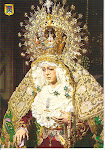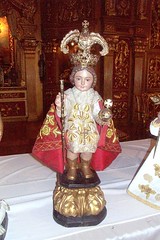My own version of the image of the Holy Child Jesus of Cebu, intrumental in the evangelization of the Philippines.
History
The discovery of the Philippines is linked to Spain's glorious chain of conquests. On September 20, 1519, a fleet of five galleons commanded by Portuguese Navigator Ferdinand Magellan at the service of the king and queen of Spain set sailed from San Lucar de Barrameda to search for the Spice Islands. They did not find the spice island, instead they landed in Limasawa, a small island south of Leyte in the central part of the Philippines. Magellan took possession of the islands and named it after King Philip of Spain.
Magellan's expedition headed for Cebu and found the island very hospitable. He made Cebu the base of his exploration, Christianization and conquests. King Humabon and Queen Juana of Cebu gave him a warm reception and embraced Christianity as well. As gratitude to his hospitality, Magellan agreed to fight with king Humabon who was at war with the neigboring tribe, Mactan. Unfortunately, Magellan was killed in the battle. His men returned to Spain, and that same expedition has set the record to be the first to circumnavigate the earth.
Spain sent another expedition to the Far East Region. An Augustinian priest, named Andres Urdaneta, a world-known cosmographer who lived inside the monastic walls of the Augustinian monastery in Mexico was summoned to lead the expedition. On November 21, a memorable expedition left Mexico for the Philippines and arrived in Cebu on April 27, 1565.
DISCOVERY OF THE IMAGE OF THE SANTO NINO
Because of Cebuanos suspicion that their return is bringing retribution to Magellan's death, another battle broke out. But heavy artilleries and huge cannons forced the natives to flee to the mountain leaving behind their villages burnt to the ground. As Spanish soldiers inspected the burnt village, one soldier found an image of the Child Jesus under the pile of ashes unscathed inside the wooden box.
As earlier authenticated entry in the Journal of Pigafetta, clerk in the Magellan expedition, explains the origin of Santo Nino: "On the day Queen Juana was baptized by Father Pedro Valderama, chaplain of that expedition, Pigaffeta himself presented her with the Image." The same Image now lies in the Basilica del Santo Nino and become a favorite destination for millions of pilgrims each year. For four and half centuries now, the Image of Santo Nino continues to make wonders in the lives of many Filipinos. On the third Sunday of each year, in Cebu, millions flock to the streets for a colorful festivity, honoring and placing the Island and the entire Philippines under His Patronage.
During the last World War, a bomb fell inside the Church but the Image was recovered unscathed. It was one of the numerous miracles and powers attributed to the Holy Image.
In 1965 the historic Santo Nino Church was renovated for the observance of the Fourth Centenary of the Christianization of the Philippines held in Cebu City. It was during the centennial celebration that the Sacred Congregation of Rites elevated the Santo Nino Church to the rank of Basilica Minore with all the rights and privileges accruing to such title.
Sunday, January 17, 2010
Subscribe to:
Post Comments (Atom)













No comments:
Post a Comment